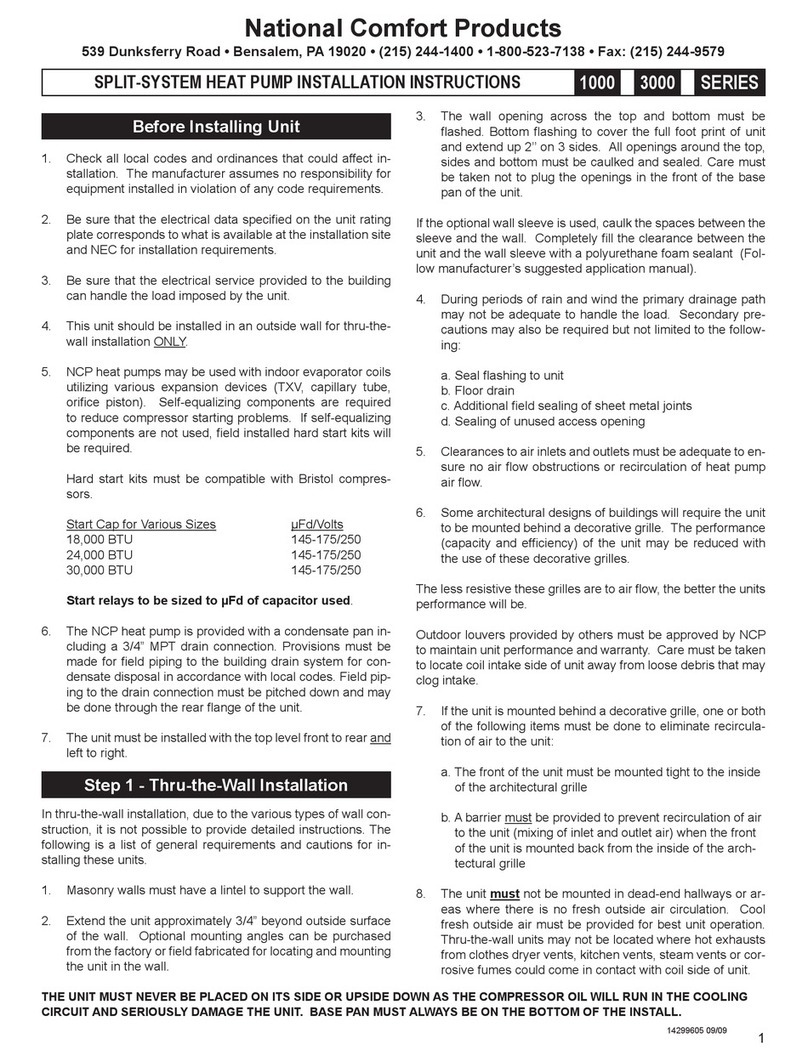
5
Installation Guide |Thru the Wall Condensing Units NCP Series 1000/3000/4000/5000
Safety Warnings!
This appliance is not intended for use by those (including children)
with reduced physical, sensory or mental capabilities, or lack of
experience and knowledge, unless they have been given supervision
or instructions concerning use of the appliance by a person
responsible for their safety. Children should be supervised to ensure
that they do not play with the appliance.
This appliance is intended to be installed up to 10,000 ft
(3,000 m) above sea level.
This appliance is only compatible with an Indoor unit that uses
R410A refrigerant.
Wheninstalling thisunitwithan indoorevaporatingunit, themaximum
operating pressure is to be considered during the installation. The
maximum operating pressure of the system should not exceed the
value as indicated on the nameplate of this condensing unit.
This model series NCP4*******-** is a PARTIAL UNIT air-
conditioner, complying with PARTIAL UNIT requirements of
the International Standard of UL-60335-2-40, and must only be
connected to the other units that have been confirmed as complying
to corresponding PARTIAL UNIT requirements of the International
Standard of UL-60335-2-40.
This is a safety alert symbol. When you see this symbol on
labels or in manuals, be alert to the potential for personal injury.
Pay particular attention to words such as DANGER, WARNING or
CAUTION.
DANGER indicates an imminently hazardous situation, which will
result in serious injury or death
WARNING indicates a potentially hazardous situation, which could
potentially result in serious injury or death
CAUTION indicates a potentially hazardous situation, which may
result in minor or moderate injury. It is also used to alert against
practices that are unsafe and can result in property damage.
!WARNING
HIGH VOLTAGE! Disconnect ALL power before servicing.
Multiple power sources may be present. Failure to do so may
result in property damage, personal injury or death.
!WARNING
These instructions are intended as an aid to qualied, licensed
service personnel for proper installation, adjustment and operation of
this unit. Read these instructions thoroughly before attempting
installation or operation. Failure to follow these instructions may
result in improper installation, adjustment, service or maintenance
possibly resulting in re, electrical shock, property damage, personal
injury or death.
!WARNING
!WARNING
!WARNING
!CAUTION
!CAUTION
Installation and repair of this unit should be performed ONLY by
individuals meeting the requirements of an “entry level technician” as
specied by National Codes. Attempting to install or repair this unit
without such background may result in product damage, personal
injury or death.
Do not use oxygen to purge lines or pressurize system for leak
test. Oxygen reacts violently with oil, which can cause an explosion
resulting in severe personal injury or death.
The unit must be permanently grounded. Failure to do so can cause
electrical shock resulting in severe personal injury or death.
Use care when handling scroll compressors. Some temperatures
could be hot!
Scroll compressors should NEVER be used to evacuate the air
conditioning system. Vacuums this low can cause internal electrical
arcing resulting in a damaged or failed compressor.
“USE COPPER SUPPLY WIRES ONLY”
!WARNING
Extreme caution should be exercised when opening the Liquid Line
Service Valve. Turn counter clockwise until the valve stem just
touches the rolled edge. No torque is required. Failure to follow this
warning will result in abrupt release of system charge and may result
in personal injury and /or property damage.




























